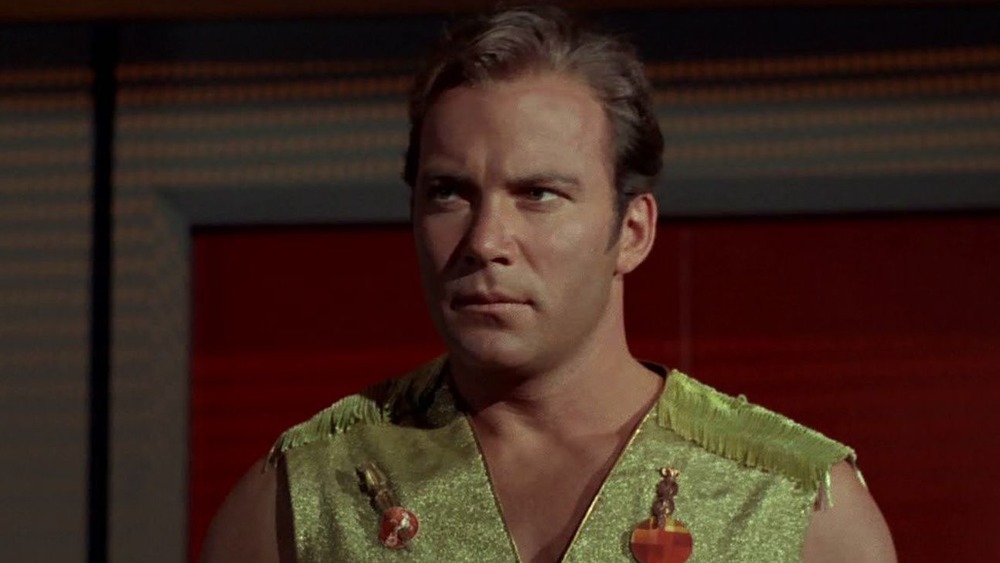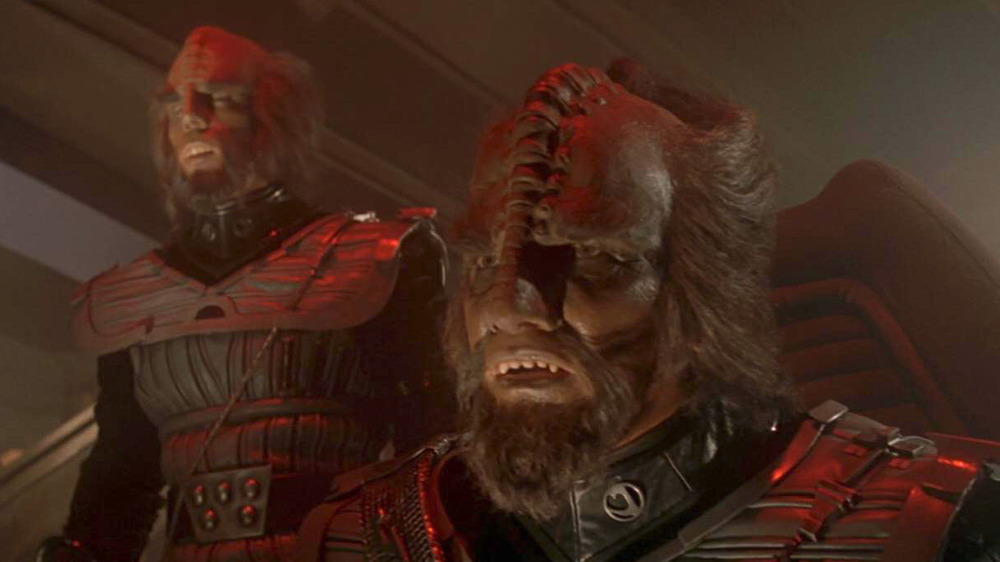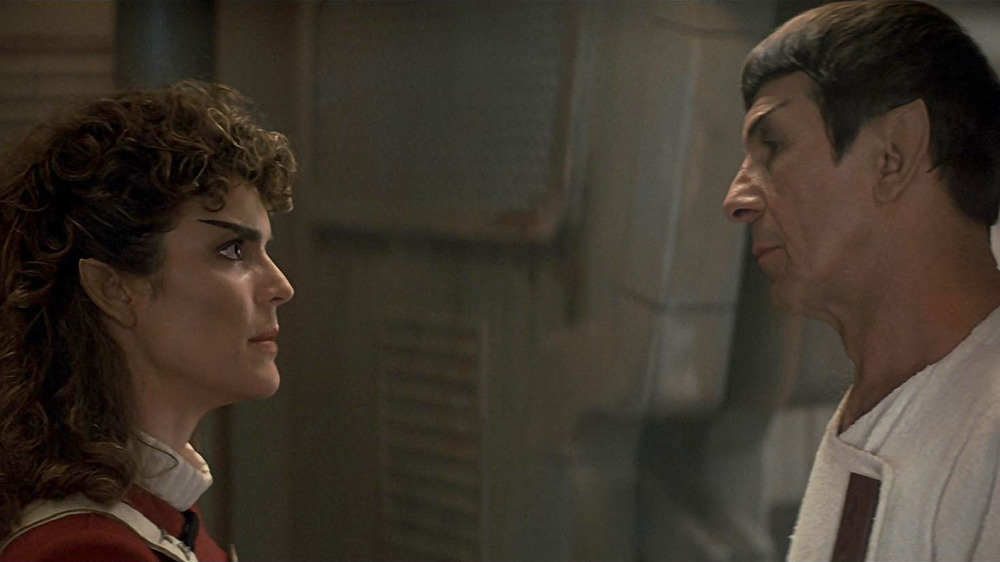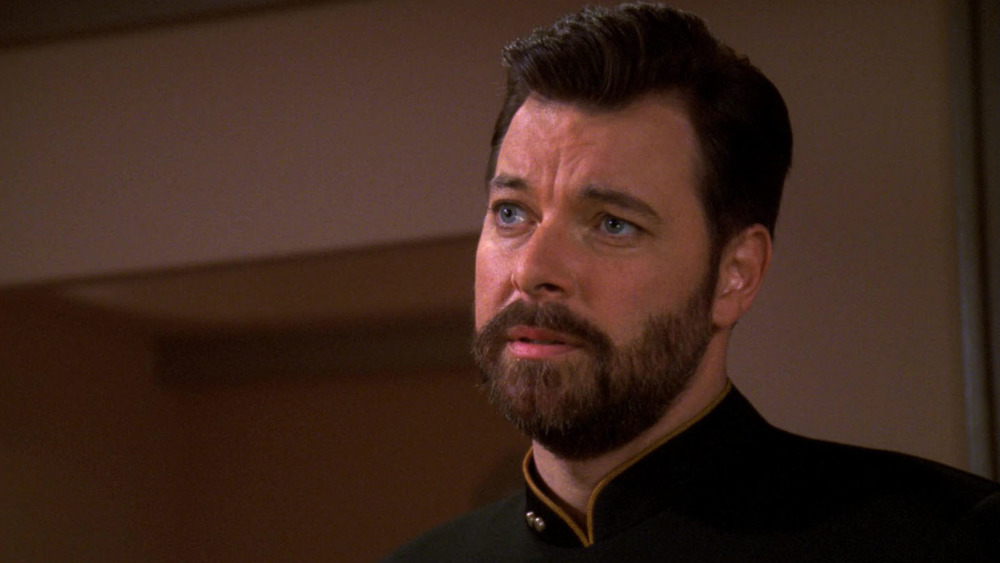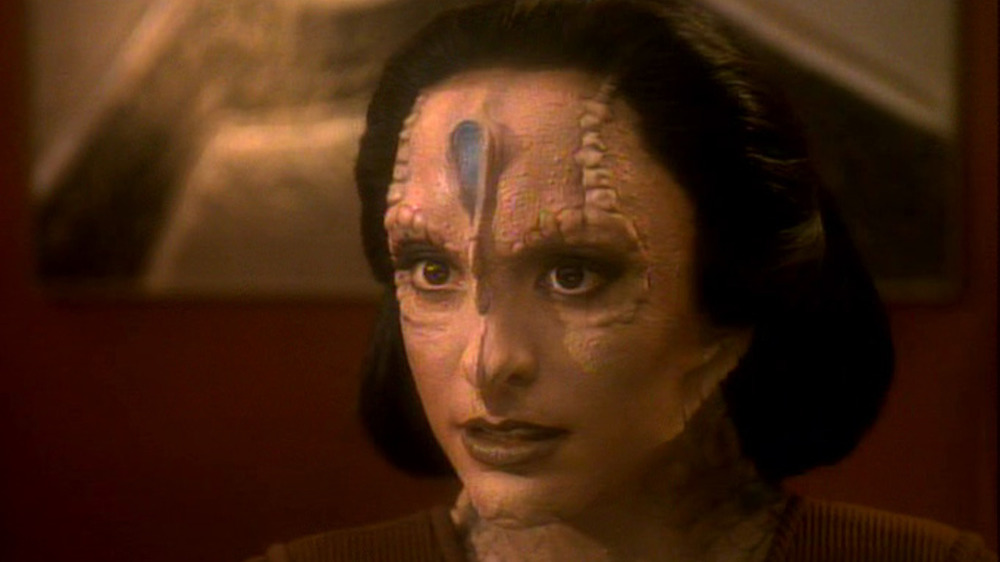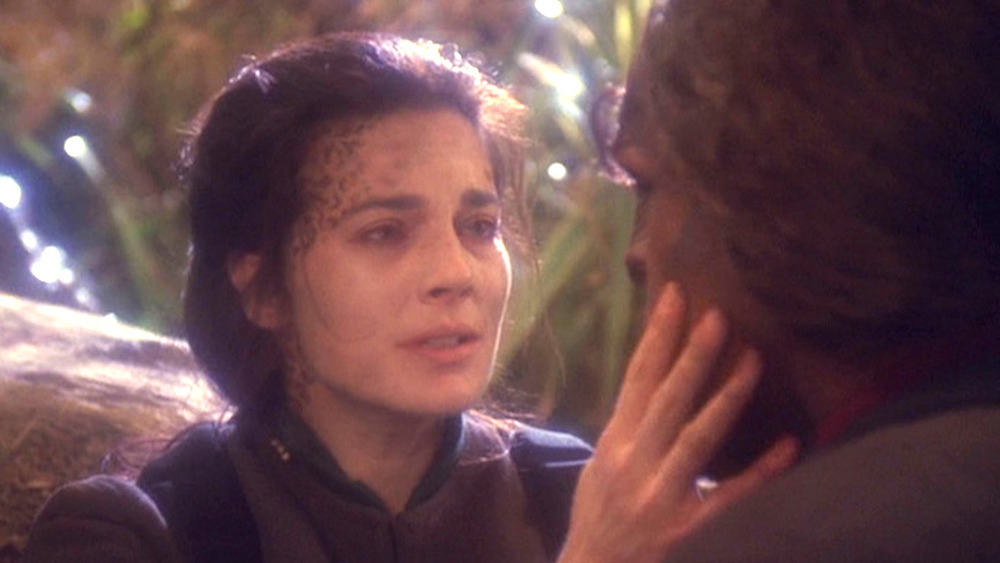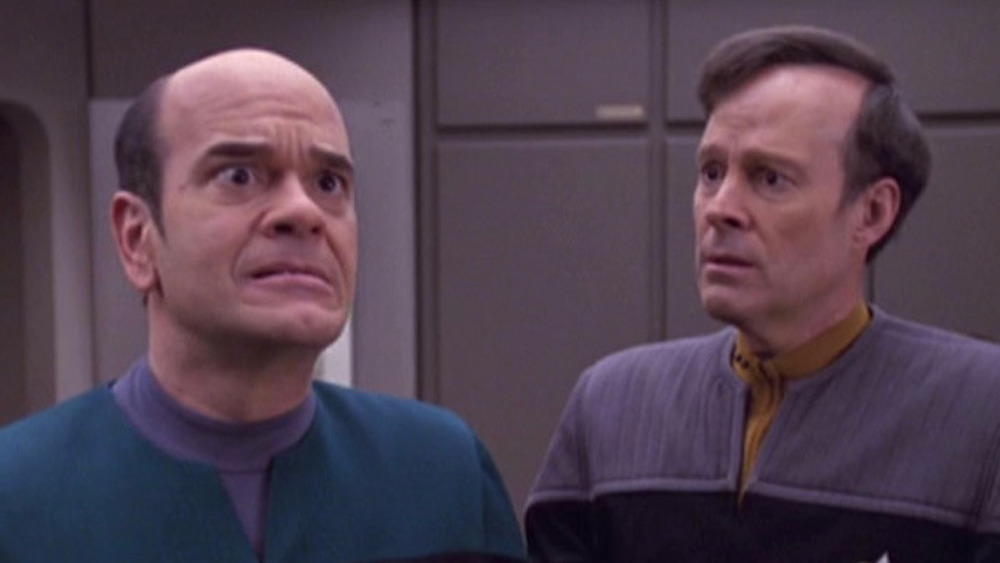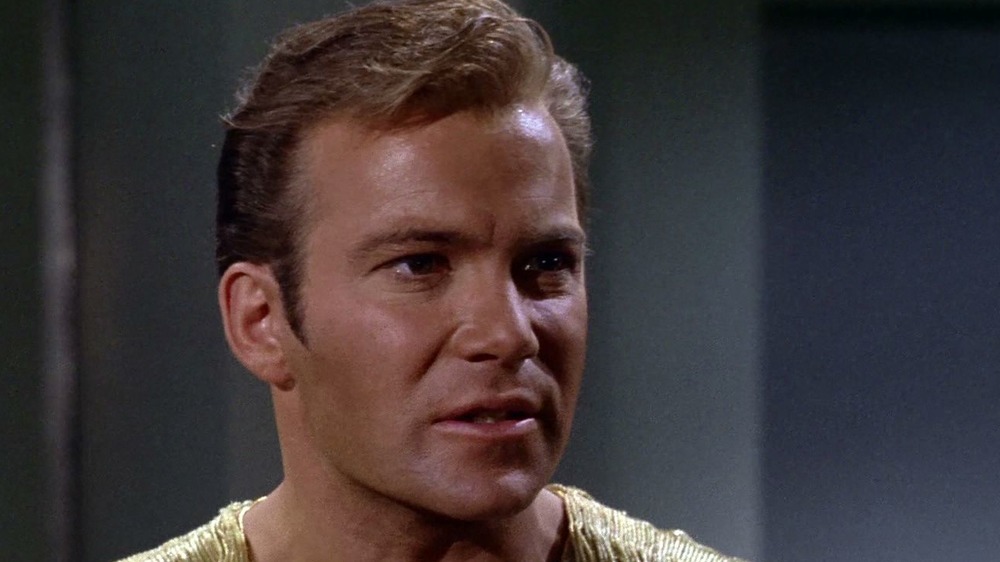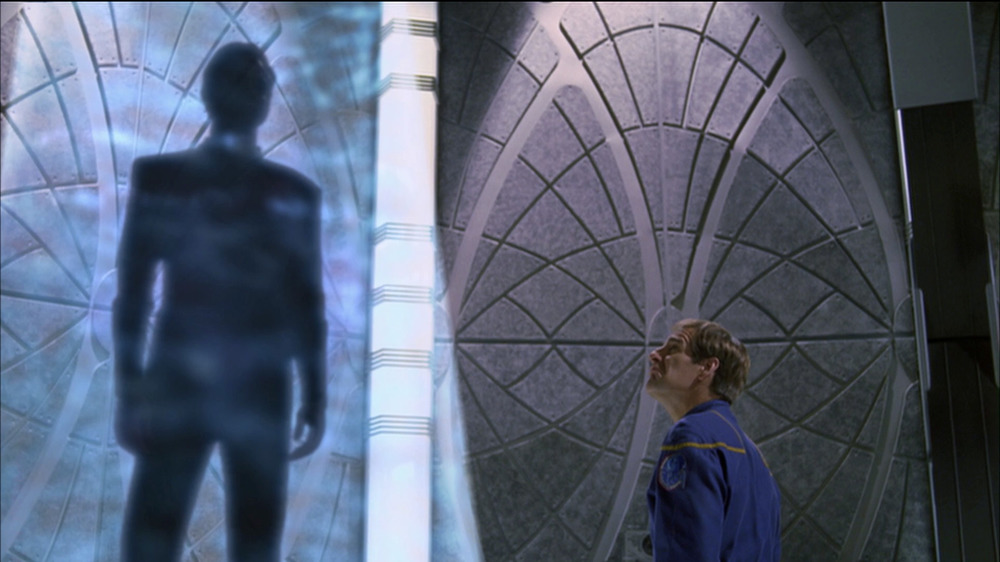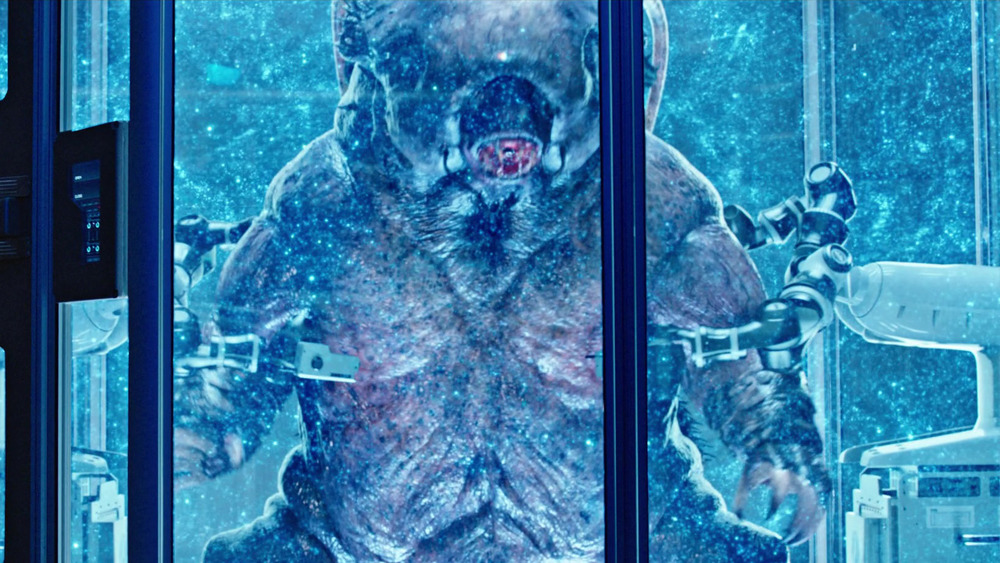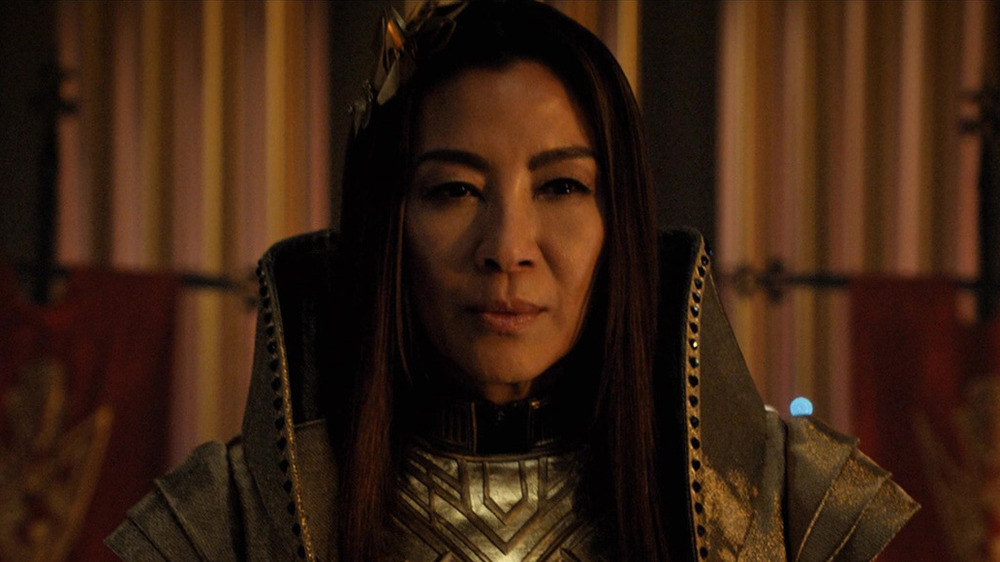Discarded Star Trek Stories That Would Have Changed Everything
The heroes of Starfleet have traveled to their share of alternate timelines over the 50-year history of the Star Trek franchise, visiting realities that branch off from their own in ways both subtle and dramatic. But behind the scenes, just as many myriad universes have been born from roads not taken by the dozens of producers and hundreds of writers who have contributed to the franchise over the past half-century.
Each creator who's lucky enough to get a turn at the rudder tries to put their stamp on the Star Trek universe while honoring what's come before, testing out countless ideas, most of which never see the light of day. Screen productions are complex organisms, and creative decisions are made and un-made for a variety of reasons — budgetary concerns, casting conflicts, or just the whim of a producer or studio who likes another idea better. Every piece of Star Trek canon that fans now hold as sacred began as just another idea on the writers' room whiteboard, subject to change at a moment's notice should a better idea (or sometimes just a more convenient idea) come to mind.
Here are just a few of the Star Trek stories that never were, which might have had a significant impact on the franchise as we know it today.
The Klingons were almost totally different
In 1977, Star Trek was set to be revived on television as Star Trek: Phase II, the flagship program for a new Paramount television network. Pre-production for the new series was well underway, and the scripts for the first 13-episode season were already selected by story editor Jon Povill. Among the stories was "Kitumba," a two-parter written by John Meredyth Lucas that would have delved deep into the history and culture of the Klingon Empire, seen only a handful of times in The Original Series.
This depiction of the Klingons, however, would have been radically different from the one that would later be developed on Star Trek: The Next Generation. They would have a different homeworld and hierarchal structure, and "Klingon" would be revealed to be the name of the warrior caste, not the species. Had this episode been produced and entered into the canon, the conception of the Klingons that followed and entered the pop culture consciousness would be unrecognizable.
Before Star Trek: Phase II started shooting, Paramount aborted their network launch and greenlit Star Trek: The Motion Picture in its place. The Klingons wouldn't receive much development until The Next Generation began in 1987, giving them a culture almost totally divorced from their 1977 reimagining.
Decades later, when fans produced their own Star Trek: Phase II (with some impressive production values), the script for "Kitumba" was adapted to conform to the version of the Klingons that had been established in the interim.
Spock and Saavik nearly had a baby
Lt. Saavik was the first new addition to the Star Trek family since Chekov who seemed to have some staying power. Portrayed in 1982's Star Trek II: The Wrath of Khan by Kirstie Alley, Saavik was Spock's protegé and seemed to be positioned as his successor after his death. In Star Trek III: The Search for Spock, Saavik was played by a new actress, Robin Curtis, in which she helps save a reborn and rapidly-aging young Spock from the life-threatening agony of pon farr, the Vulcan mating imperative.
Saavik's role is much smaller in the next sequel, Star Trek IV: The Voyage Home – essentially a cameo. Instead of joining the rest of the crew on they journey back to Earth, Saavik stays behind on Vulcan with no explanation. But in an earlier draft of the script (as confirmed in the director's commentary track for the film), Saavik's reason for remaining on Vulcan was explicit — her encounter with Spock on the Genesis Planet has led to a pregnancy, which she wants to see to term on her homeworld.
Saavik and Spock co-parenting a child would have had major repercussions for the film series. For one, Spock becoming a parent would change things for him, and introduce a new character that likely would have become a big deal, at least by now. Second, it would have made Saavik a more difficult character to discard. Instead, she's never heard from again.
Riker could have been replaced by his transporter twin
In the sixth season Next Generation episode "Second Chances," Commander William Riker returns to a strange planet from which he barely escaped years earlier. As it turns out, he didn't escape, or, rather, one version of him didn't. Thanks to a double transporter lock — one successful, one not so much — Riker was simultaneously beamed away and left behind on the planet, where he spends the past eight years alone. Once rescued, the forgotten Will Riker wants to pick up his life where he left off, only to find that there's another Will Riker in his way.
While developing the episode, producer Jeri Taylor and the rest of the writing staff seriously considered getting the familiar Riker out of the way, killing him off and keeping the newly-discovered Lt. Riker aboard. This would shake up the dynamics between the characters without having to change the real-life cast, and rid the writers of a character they were having a hard time coming up with stories for. This idea was popular in the writers' room and was pondered by folks as high up the ladder as Executive Producer Rick Berman, who ultimately decided that it would be too big a shake-up, and would definitely be confusing for mass audiences once the TNG cast headed for the big screen.
Instead, the duplicate, now going by the name Thomas, would follow a different path and guest star in a single episode of Deep Space Nine.
A bunch of characters were almost secretly aliens
During the Rick Berman era of Star Trek spin-offs (TNG, DS9, Voyager, and Enterprise), one plot twist continued to be pitched, developed, and scrapped over and over again: that a regular cast member would discover that they're actually a different species. On TNG, Jeri Taylor pitched a story in which Geordi LaForge would learn that his father is actually not human, and that he is the product of an alien experiment. According to a Deep Space Nine DVD featurette, two characters were considered to have been secret Cardassian agents all along. Originally, it was Miles O'Brien who would have been replaced, but when this presented logical issues, the story was redesigned around Kira Nerys and became the episode "Second Skin," in which Kira is told that she's actually a Cardassian sleeper agent. The produced episode reveals this to be a deception, but originally Kira's true identity would have been left ambiguous.
In the Voyager episode "Favorite Son," Ensign Harry Kim is told that he's actually a lost member of the Nasari race. Once again this was revealed to be untrue, but writer Lisa Klink and actor Garrett Wang each confirmed in Star Trek: Voyager Magazine interviews that originally the twist was for real, and Kim would have stayed in alien makeup for the rest of the series.
Finally, Enterprise staff writer Mike Sussman wanted to reveal in that show's unproduced fifth season that Vulcan science officer T'Pol was actually half-Romulan.
Worf could have left Jadzia to die
In "Change of Heart," a sixth season episode of Deep Space Nine, married couple Jadzia Dax and Worf are sent together on a dangerous and critical mission to collect a defecting Cardassian officer. But when Dax is injured behind enemy lines, Worf abandons his objective to save her life, leading to the Cardassian asset being discovered and killed.
By the time the actor playing Jadzia, Terry Farrell, received the script for "Change of Heart," she had already determined that she would be leaving the show at the end of the season, and thought that if her character was going to killed off, this should be how it happens — with Dax convincing Worf to let her die in order to complete the mission.
"I had asked not to be killed," explains Farrell in a DS9 DVD featurette, "but if you need to kill me because that's what you need to do, that would have been the perfect episode to do it because it would have been so much more for Worf's character to play in the long run."
Farrell got neither of her wishes: instead of dying in "Change of Heart" or becoming a recurring or guest character, Dax is killed suddenly by Gul Dukat in the season finale 10 episodes later, in a story development that had little to do with her. The circumstances of Farrell's departure from the show remain the subject of controversy and hurt feelings over 20 years later.
Barclay could have been The Doctor's dad
In 1993, writer/producer Jeri Taylor was tasked not only with wrapping up The Next Generation but also setting up the next spin-off, Star Trek: Voyager. At one point in the development of Voyager, Taylor suggested seeding the premise of the new show's Emergency Medical Hologram as a B-plot on a Next Generation episode, in which Holodeck-savvy Lt. Reginald Barclay (Dwight Schultz) would be putting the finishing touches on the EMH. Taylor even suggests that Schultz should be considered for the role of The Doctor on Voyager, having Barclay create the EMH in his own image.
This idea was discarded in favor of casting an actor that was new to Trek, Robert Picardo, who would later also play The Doctor's creator, Dr. Lewis Zimmerman. Picardo put a great deal of himself into the character, developing him from a cranky, no-nonsense physician with fairly little screen time to the exuberant opera aficionado who became one of the show's breakout characters. Having anyone else play the role would have led to a very different result, but in particular, the shy, awkward Barclay is practically his total opposite. Barclay would later recur on Voyager as part of the effort to bring the lost crew home, while also befriending both The Doctor and Dr. Zimmerman.
Archer would have met Mirror Kirk and created the Mirror Universe
During development of the fourth season of Enterprise in 2004, show creators Rick Berman and Brannon Braga and showrunner Manny Coto met with legendary Star Trek actor William Shatner regarding the latter's interest in making a guest appearance. Shatner pitched a story developed by himself and his frequent novelist collaborators Judith and Garfield Reeves-Stevens in which Shatner would have portrayed Tiberius, Captain Kirk's Mirror Universe counterpart. Tiberius would have been sent back in time and across dimensions, where he would encounter the Prime Universe's Captain Archer and his Enterprise. In their efforts to get Tiberius home to his own timeline, Tiberius and Archer would discover that they are actually responsible for the creation of the Mirror Universe itself.
The producers answered Shatner's pitch with another story in which he would portray the NX-01's enigmatic Chef, who would turn out to be an ancestor of Kirk's and assume his identity for a time travel adventure. This pitch was met with, in Coto's words, "a long silence," and the collaboration fell apart. It's truly hard to imagine a Star Trek production that was already on the bubble for cancellation counter-pitching William Shatner and losing the guaranteed ratings and attention bump his appearance would have garnered.
Instead, the fourth season proceeded with a different nostalgia-fueled Mirror Universe two-parter, "In a Mirror, Darkly." According to a DVD commentary, it was while shooting that very episode that the production was informed of Enterprise's cancellation.
Archer was 'Future Guy' all along
From the very first episode of Enterprise, a mysterious figure from the future manipulates historical events through his Suliban agents as part of the Temporal Cold War. This character is only ever seen via a distorted transmission and never given a name or a face. He was portrayed by actor James Horan (a frequent Star Trek guest star) and credited as "Humanoid Figure," but fans typically refer to him by the nickname "Future Guy."
The Temporal Cold War arc that ran through the first two seasons was put on hold in favor of the year-long Xindi arc, and then seemingly concluded in Season Four with "Storm Front, Parts I & II." But according to series co-creator Brannon Braga, Enterprise wasn't done with "Future Guy" — had the series not been canceled, it would have been revealed that the shadowy puppetmaster was actually Jonathan Archer all along, "trying to repair a corrupt future by influencing his innocent past self."
This would have revitalized a disappointing storyline and also given Archer himself some much-needed flavor. "Future Guy" had been positioned to be, potentially, the show's Big Bad, and to have him actually be the main hero of the story would recontextualize and maybe even retroactively repair a lot of messy storylines from the show's early years.
Since Archer being "Future Guy" never became canon, apocryphal novels and video games have given him distinct names and origins, none of them being Jonathan Archer.
The tardigrade would have been part of the Discovery crew
Early in the first season of Star Trek: Discovery, the crew discovers that the key to their experimental Displacement Activated Spore Hub Drive is employing a giant space tardigrade — a sentient creature who lives in space and can travel faster than light — as its navigator. Captain Lorca initially captures one and forces it to operate the spore drive against its will until Burnham and the crew convince him to set it free. Lt. Stamets would later incorporate tardigrade DNA into his own body in order to take the tardigrade's place as a willing navigator.
However, Season One showrunners Aaron Herbert and Gretchen Berg originally had a very different plan for the tardigrade — he would have been a part of the crew from the beginning, a Starfleet officer named Ephraim. He would have had dialogue, a station on the bridge, and a custom uniform to accommodate his unusual size and shape.
This idea was abandoned, likely due to the expense of having a fully computer-generated character on episodic television. The tardigrade in the animated Short Treks episode "Ephraim and Dot" inherits her name from this abandoned character concept, who in turn was named after Johann August Ephraim Goeze, the 18th century zoologist credited with discovering tardigrades.
Discovery would have introduced a completely new Mirror Universe
The back half of Star Trek: Discovery's first season sends the crew to the Mirror Universe, where they must pose as their evil counterparts while they search for a way to return home. While there, Michael Burnham meets Emperor Georgiou, the Mirror duplicate of her mentor who died as a consequence of Burnham's mutiny in the series premiere. Burnham ends up bringing this Georgiou back to the Prime Universe, where she remains a recurring character for the next two seasons of Discovery and is expected to lead her own spin-off.
But if series co-creator Bryan Fuller had remained aboard the series, rather than being ousted early in the production, Discovery wouldn't have visited the Mirror Universe as we know it. Instead, the series would have its own take on it, not one based on evil doppelgangers, but one that would branch off from the series premiere and force Burnham to confront her fateful decision.
"I wanted the Mirror Universe to function in a narrative exploration of, like, 'Oh f***, if I just didn't do that one thing, everything would be better,'" said Fuller in a YouTube interview, "as opposed to, 'I don't recognize that person, I don't know who that person is, because they are a diametric opposite of who I am.'"
This is an intriguing twist on an old Trek standard, but probably would have meant never meeting Emperor Georgiou, let alone seeing Michelle Yeoh's new Star Trek series.
